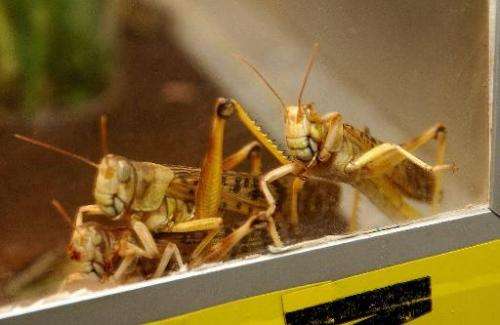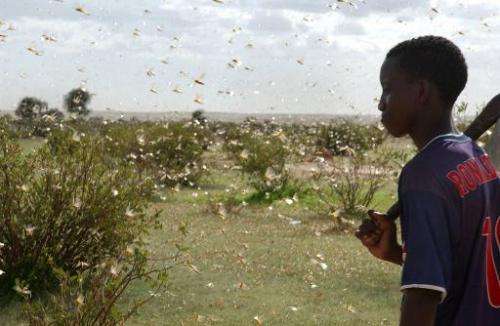Locust genome exposes 'hundreds' of pesticide targets

Chinese scientists said Tuesday they had unravelled the genetic code of the locust, laying bare "hundreds" of genes that can be targeted by insecticides.
The genetic code of Locusta migratoria is remarkably big—at 6.5 gigabytes, it is the largest animal genome sequenced so far, they reported in the journal Nature Communications.
Large clusters of the insect's genes are associated with long-distance flight, eating plants and metabolising food, they said.
But there are also many repeated, mobile sections of DNA, called transposable elements, that were never weeded out by evolution and remain in the genome, the scientists said.
An ancient peril that can eat its own bodyweight in food in a single day, the locust is capable of inflicting famine and wiping out livelihoods when it swarms.
In one of the biggest documented events, billions of locusts swarmed across 29 million square kilometres (11.2 million square miles) of land in 60 countries in 1988, even crossing the Atlantic from Africa to the Caribbean.
The genome code is a draft, but once it has been polished, could serve a blueprint for scientists seeking new ways of attacking the voracious insect.
It throws up "hundreds of potential insecticide target genes," according to the probe, headed by Le Kang of the Institute of Zoology at the Chinese Academy of Sciences in Beijing.

Finding a smart, environmentally friendly way to kill the pest is a major goal, the authors noted.
Previous work into locusts has found a biochemical mechanism that prompts the creatures to swarm.
Locusts are usually solitary, but are stimulated into gathering and searching for food en masse by jostling, which triggers serotonin, a pleasure chemical in the brain.
Once in swarm mode, locusts change colour from green to bright yellow, gaining large muscles that equip them for prolonged flight.
More information: dx.doi.org/10.1038/ncomms3957
Journal information: Nature Communications
© 2014 AFP





















